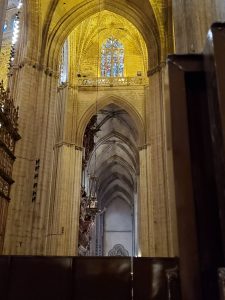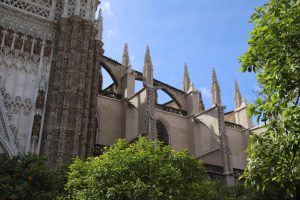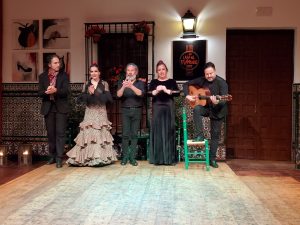
The weather is still holding. It was partially cloudy with some periods of sun today.
We found an acceptable place to have breakfast today. We resorted to looking at TripAdvisor reviews in the area of the Cathedral, where we were headed. It is called FILO. It is small and, as the review said, crowded. The breakfast menu was not large, but it had enough to choose from. We each had something different than we had been eating for breakfast and that made for a nice change. Breakfasts, even in a relatively expensive city like Seville, are affordable. Finding a good place to eat—and get coffee—is also an incentive to get out and about earlier than we might otherwise.
The Seville Cathedral is the largest Gothic church in the world and about the 10th largest church. Each time I visit I try to take pictures that capture the enormous space, but I am never successful. How large is the church? It is so large that as soon as we get inside, Patricia and I set a meeting place and time in case we get separated. I don’t think you could find a person in there without a good bit of luck and a lot of time.
I mentioned the periods of sun. One coincided with our visit to the Cathedral this morning. The light coming through the stained glass, which is the only light from the outside, was just right to illuminate the vivid colors of the glass and the high ceilings. [I’m not sure if “ceiling” is the right architectural term for something that is 138 feet above the floor.] So I wandered around, looking at the architecture and fixtures, all the time impressed by the scale. There weren’t enough visitors to make the Cathedral seem crowded, but there were many people in tour groups, so there were “lumpy” places that were busy for a minute or two.
The interior of the cathedral is lined with chapels, and the chapels themselves were built, or at least finished, at different times. The stonework, statues, icons, and paintings are different from chapel to chapel. At the time of day we visited—late morning—some of the chapels did not get much light and sometimes the windows above the chapels showed hardly any color. I should point out that most of the stained glass is high above the ground and just as with the other construction not all of it was installed in the original building but over the succeeding centuries. I can only imagine the conversations that took place when it was time to install an new piece of stained glass 125 above the floor. Do stained glass windows go in as a single unit or are they constructed in place? Did someone say “get out the big ladder, we’ve got a new window” or would the installation have been a large construction problem? [I’m only kidding about the ladder. They may have use hot air balloons to get up that high for all I know.]
We spent a couple of hours in the cathedral and its courtyard. Like going to any great museum or natural wonder it is easy to get overwhelmed.
After the Cathedral, we stopped at the Museo de Baile Flamenco. They have a good selection of flamenco-related CDs in their shop. I was looking for a magic instructional CD that would instantly teach me the compás for bulerías. That is one compás, built on a 12-count, that I just can’t get. Every now and then while I am watching a performance and [quietly] keeping time, I think, just for a few seconds, “I have it!” But I am always wrong. I did not find that magic CD today. All of their CDs expected me to actually practice.
Patricia had been admiring a top in a store window we pass by frequently. She went in early this morning to look, but came out empty-handed. We both knew that could not last so she went back in this afternoon and bought a nice top.
We had lunch in a Mexican cafe. We have been eating there ever since we started visiting Seville. Their food is served tapas style and is nothing like Northern New Mexico food. We enjoyed our lunch.
This evening we went back to La Casa del Flamenco for another performance. We met a couple of men there whom we had seen in Jerez and had a nice conversation with them. We also had the rare good fortune to introduce a couple to their first flamenco performance. We could not have picked a better first show for them to see. Luisa Palacio (whom we saw in TEMPus in Jerez) and El Nano (bailaores), Ana Gómez and Jordan José Amador (cantaores), and Rúben Romero (guitarra) gave an exciting show. The whole audience gave thunderous applause on several occasions. El Nano danced with power and grace and Luisa Palacio was even better at this venue than in the show we saw in Jerez. A great flamenco show causes me the same description problems as a visit to the Cathedral. Words can’t describe them. They must be experienced.



